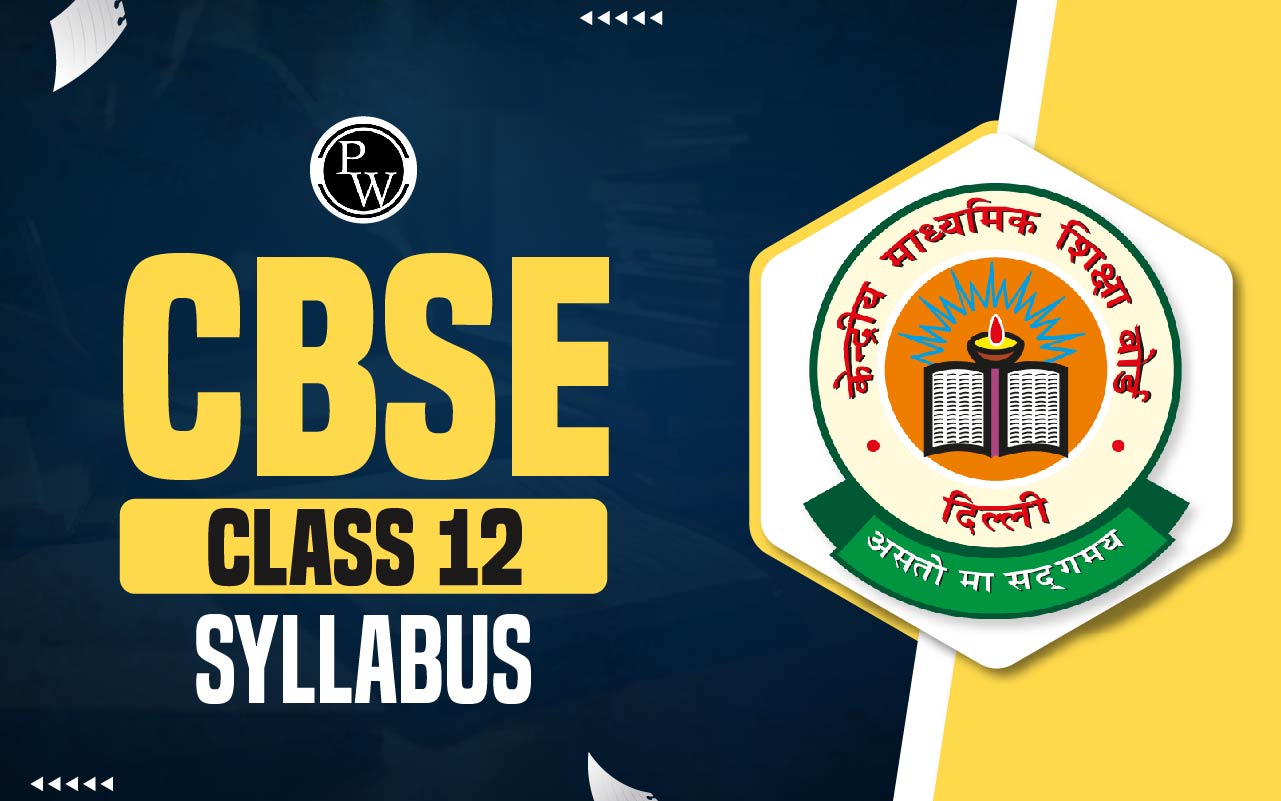
CBSE Class 12 Physics Notes Chapter 8: Chapter 8 of CBSE Class 12 Physics focuses on Electromagnetic Waves, which are transverse waves composed of oscillating electric and magnetic fields. These waves travel at the speed of light and are generated by accelerating charges. The chapter explains how a changing electric field induces a magnetic field and vice versa, as described by Maxwell’s equations.
The electromagnetic spectrum, including radio waves, microwaves, infrared, visible light, ultraviolet, X-rays, and gamma rays, is discussed along with their practical applications in communication, medical imaging, and other technologies.CBSE Class 12 Physics Notes Chapter 8 Overview
Chapter 8 of CBSE Class 12 Physics covers Electromagnetic Waves, an essential topic that bridges the concepts of electricity, magnetism, and light. Electromagnetic waves are oscillations of electric and magnetic fields, which propagate through space at the speed of light. These waves are transverse in nature, meaning the electric and magnetic fields oscillate perpendicular to the direction of wave propagation and to each other. The chapter explains how a changing electric field produces a magnetic field and vice versa, leading to the generation of electromagnetic waves. Maxwell's equations are fundamental to understanding this phenomenon, as they mathematically describe how electric and magnetic fields interact and propagate. Electromagnetic waves encompass a wide spectrum, including radio waves, microwaves, infrared, visible light, ultraviolet, X-rays, and gamma rays, each differing in wavelength and frequency. The chapter also explores the applications of these waves, ranging from communication (radio, TV) to medical imaging (X-rays), and their interaction with matter. Understanding the nature of electromagnetic waves is crucial for grasping the principles behind many modern technologies.CBSE Class 12 Physics Notes Chapter 8 PDF
Here we have provided CBSE Class 12 Physics Notes Chapter 8 Electromagnetic Waves pdf for the ease of students so that they can prepare better for their exams by downloading the pdf easily and using it without any internet.CBSE Class 12 Physics Notes Chapter 8 PDF
CBSE Class 12 Physics Notes Chapter 8 Electromagnetic Waves
Here we have provided CBSE Class 12 Physics Notes Chapter 8 Electromagnetic Waves - Waves related to electricity and magnetism are known as electromagnetic (EM) waves. In essence, these waves are coupled, time-varying magnetic and electric fields that travel through space. These waves would undoubtedly spread throughout space since they are connected to electricity and magnetism. Electromagnetic waves are produced when electric and magnetic fields combine and change over time. Maxwell's equations serve as the foundation for electromagnetic equations. Maxwell came to the conclusion that these EM waves had a wide range of unique qualities that can be used to a variety of real-world scenarios.Time varying electric field + Time varying magnetic field = Electromagnetic waves.
A linearly polarised electromagnetic wave is shown in the above diagram to be travelling in the z-direction with an oscillating magnetic field B in the y-direction and an oscillating electric field E in the x-direction.
Maxwell’s Experiments
According to Maxwell, magnetic fields can be produced by time-varying electric fields. However, according to the Faraday-Lenz rule, an electric field is produced by a time-varying magnetic field. The Faraday-Lenz law states that any time the magnetic flux associated with a circuit varies, an EMF is induced in that circuit. As a result, the circuit that has an electric field connected to it produces electric current. Upon discovering this, Maxwell asserted that the opposite must also be true, meaning that a time-varying electric field must also possess the ability to produce a magnetic field.Ampere’s Circuital Law
 Maxwell did discover several discrepancies in Ampere's circuital law, though.
As a result, it was discovered that Ampere's circuital law was accurate in certain situations but not always.
For this conclusion, Maxwell studied a variety of scenarios. He attempted, for example, to measure the magnetic field in a section of a capacitor at a certain place.
He calculated the value of B at point P, as indicated in the next figures, assuming that there was some current I flowing through the circuit.
He took into consideration the three distinct loops depicted in the pictures below.
Ampere's circuit law ought to apply to each of these three configurations if it was accurate.
Maxwell did discover several discrepancies in Ampere's circuital law, though.
As a result, it was discovered that Ampere's circuital law was accurate in certain situations but not always.
For this conclusion, Maxwell studied a variety of scenarios. He attempted, for example, to measure the magnetic field in a section of a capacitor at a certain place.
He calculated the value of B at point P, as indicated in the next figures, assuming that there was some current I flowing through the circuit.
He took into consideration the three distinct loops depicted in the pictures below.
Ampere's circuit law ought to apply to each of these three configurations if it was accurate.

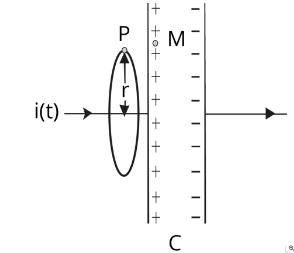
Case 2:
Maxwell considered a surface, like a box with its lid open and applied the Ampere’s circuital law;
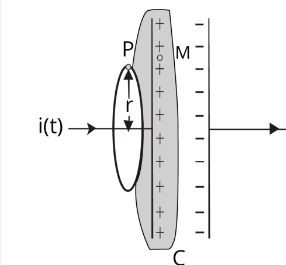

Maxwell’s correction to Ampere’s law
According to Ampere's equation, if the electric field inside the loop is constant, the line integral of the resultant magnetic field along a closed plane curve equals μ0 times the total current crossing the area defined by the closed curve. This law only applied to currents that were stable. After discovering the flaws in Ampere's law, Maxwell updated it to include time-varying electric fields. Maxwell considered that there must be some current flowing between the capacitor's plates in order for Ampere's circuital equation to be accurate. Electron flow was the cause of current outside the capacitor. Between the capacitor's plates, there was no charge conduction. Maxwell states that there should be an electric field between the capacitor's plates that is directed from the positive to the negative plate.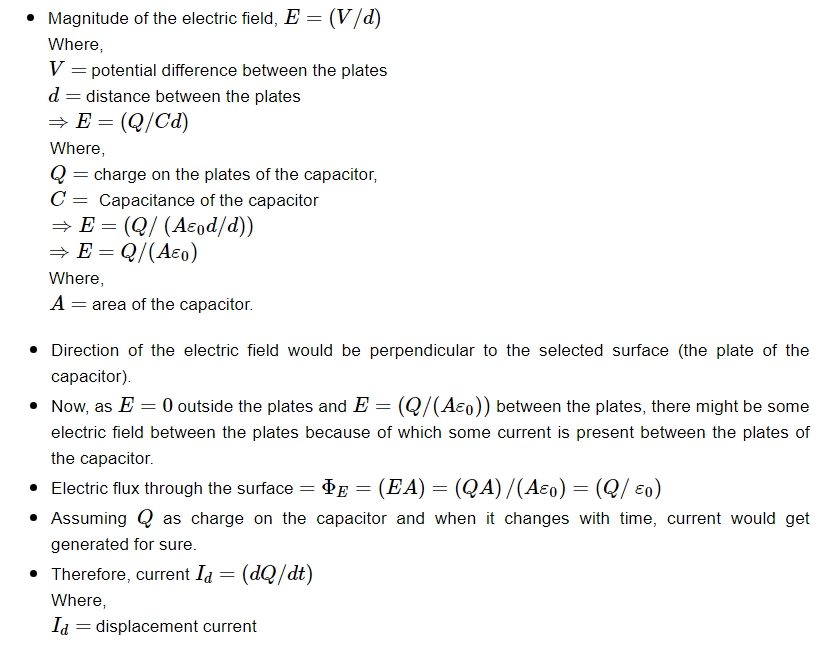
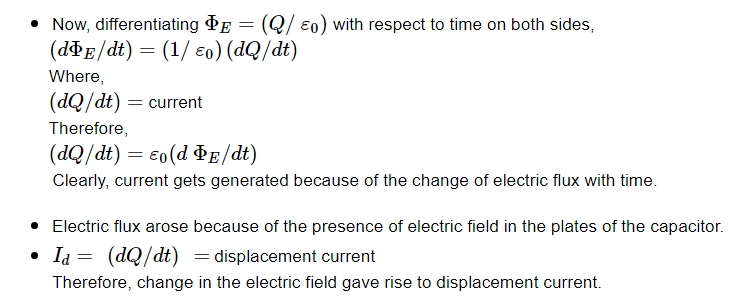 Instead of being zero, current would be Id.
Both the surface and the spaces between the capacitor's plates are experiencing some current.
There are times when just conduction current exists and no displacement current, and vice versa.
Maxwell added displacement current to the Ampere's circuital law.
He explained that in addition to the current flowing through the capacitor's outside, there was also a current flowing between its plates that was referred to as displacement current.
Furthermore, the shift in the electric field between the capacitor's plates is the cause of this displacement current.
Instead of being zero, current would be Id.
Both the surface and the spaces between the capacitor's plates are experiencing some current.
There are times when just conduction current exists and no displacement current, and vice versa.
Maxwell added displacement current to the Ampere's circuital law.
He explained that in addition to the current flowing through the capacitor's outside, there was also a current flowing between its plates that was referred to as displacement current.
Furthermore, the shift in the electric field between the capacitor's plates is the cause of this displacement current.
Conclusion:
Magnetic fields are produced both by conduction currents and by time varying fields.
Figure (a) represents the electric and magnetic fields E and B between the capacitor plates at the point M M while figure (b) represents a cross-sectional view of figure (a).
Ampere-Maxwell Law
Maxwell's correction of Ampere's circuital law's flaws led to the law's subsequent renaming as Ampere-Maxwell law. Conduction current is the type of current that results from the movement of charges. Ic is used to represent it. Displacement current is the term for the current that results from an alteration in the electric field. Id is used to represent it.
Displacement Current
Think about a capacitor and the conduction current (IC) that exists outside of its plates. Allow a displacement current, Id, to exist in the space inside the capacitor—that is, between the plates. The displacement current has the same physical characteristics as the induction current. The table below now shows the distinction between displacement current and conduction current: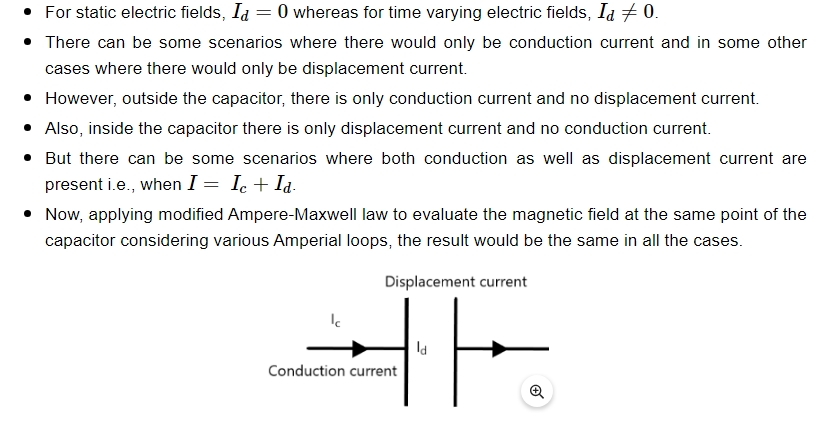
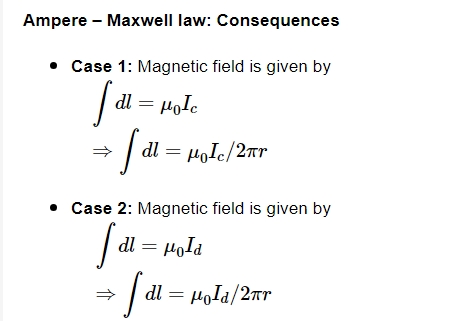
Conclusions:
In all scenarios, B has the same value. There must be an equal total current. Ampere-Maxwell law provides the magnetic field that is produced by a time-varying electric field. Taking into account the initial phase, an electric field exists between the plates, and it changes with time. A magnetic field is created as a result of the displacement current that results from this. The Faraday-Lenz law provides an electric field that is generated by a time-varying magnetic field. It is obvious that a changing electric field produces a changing magnetic field, and a changing magnetic field produces an electric field. This result serves as the foundation for electromagnetic waves.Maxwell’s Equations
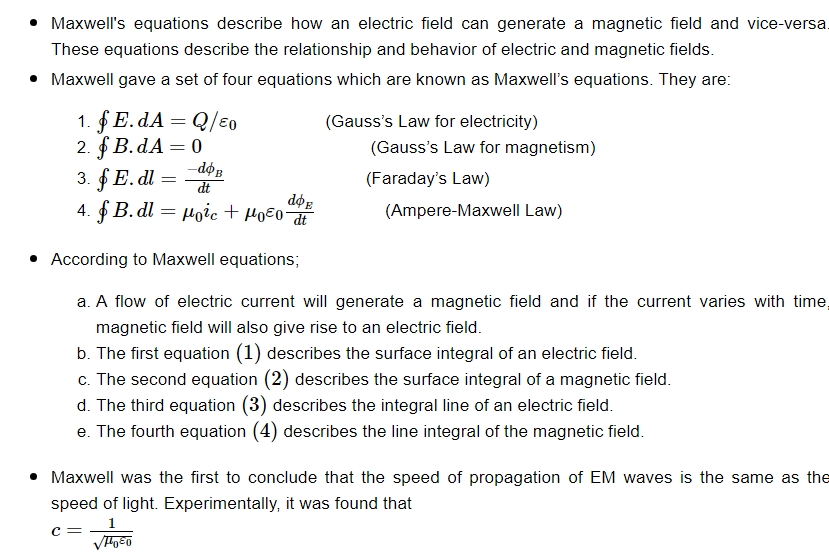
Electromagnetic Waves
Sources of Electromagnetic Waves (EM)
When electrically charged particles oscillate, they accelerate charges and produce electromagnetic waves. A oscillating magnetic field is produced by the electric field vibration connected to the accelerating charge. Electromagnetic waves are produced by these oscillating electric and magnetic fields. The charge's accompanying electric field would likewise remain static while the charge is at rest. Because the electric field does not change with time, there would be no production of electromagnetic waves. The acceleration is 0 when the charge moves at a constant speed. Again, no electromagnetic waves would be produced as the electric field's change over time is likewise constant. This demonstrates that EM waves can only be produced by accelerating charges. Think about a charge particle that is oscillating, for instance. Its fluctuating magnetic field is caused by its oscillating electric field. An oscillating electric field is then produced by this oscillating magnetic field, and so on. Wave propagation and electric and magnetic field regeneration are the same thing. An electromagnetic wave is one of these waves that exhibits all of these characteristics. It should be remembered that an electromagnetic wave's frequency is always the same as the frequency of the oscillating particle that produces it.Electromagnetic Spectrum
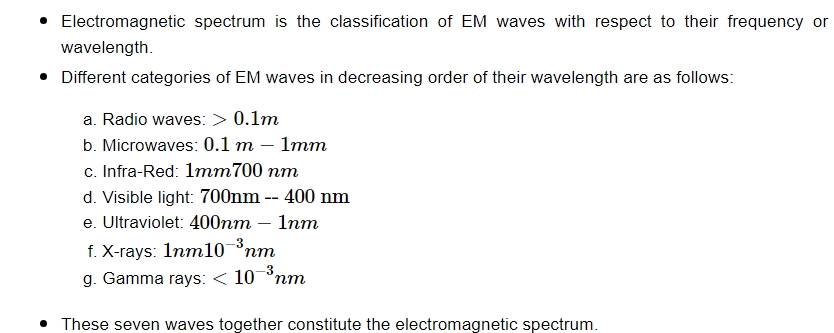
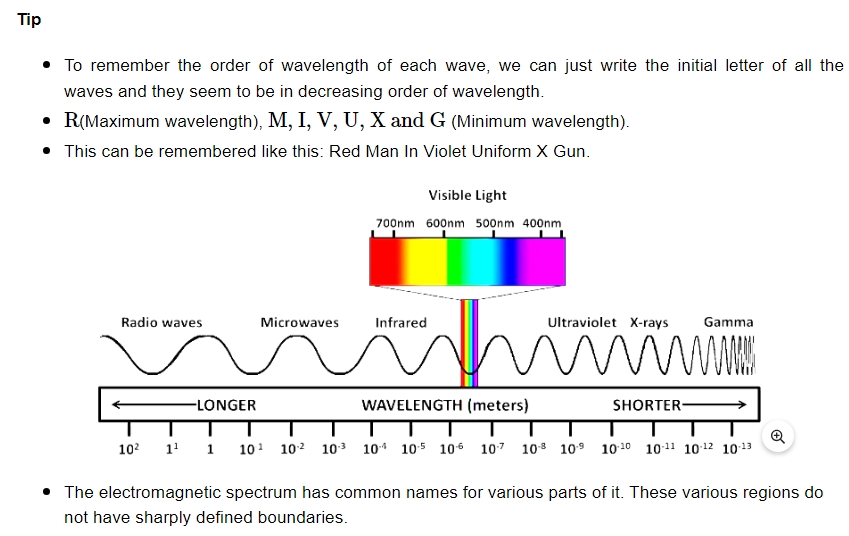
Electromagnetic energy of each wave in Electromagnetic Spectrum

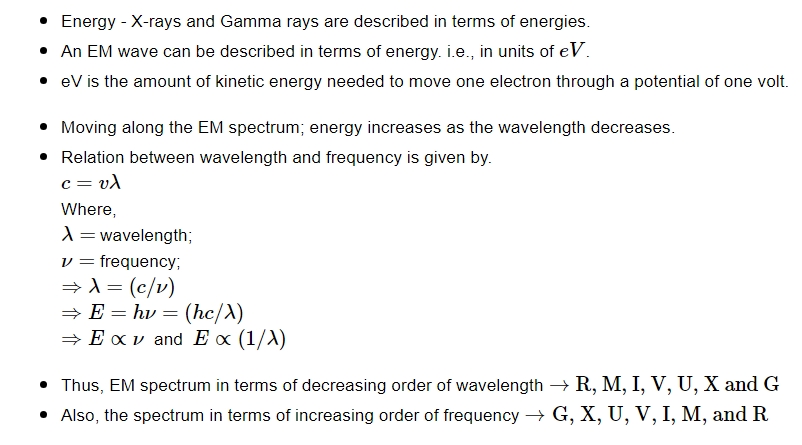
Radio Waves

Micro Waves
Short-wavelength radio waves are called microwaves. Special vacuum tubes, known as klystrons, magnetrons, or Gunn diodes, are used to produce them. They are utilised in radar systems for aviation navigation and microwave ovens.RADAR Technology
RADAR - Radio detection and ranging.
Different applications of RADAR:
To regulate air traffic: air traffic control. The pilot has to know whether or not there are any other aircraft in the area. The weather at takeoff and landing should also be known to the pilot. In order to navigate an aeroplane, radar is essential. Speed detection: Radar technology is employed by the devices that measure the speed of moving cars on public roadways. For military use: It aids in the detection of adversaries and armaments. Satellite tracking: Radar technology is used to track satellites.Why do radio waves use microwaves?
because they employ microwave-like short wavelength waves. To human eyes, they are invisible. It would be really annoying if we could see the waves that are sent. It is simple to find even the smallest microwave presence.Working of Radar Set
It consists of:
Microwaves are sent by the transmitter. Receiver: It picks up the echoes that come from hitting any kind of object with microwaves. It is feasible to monitor the existence of additional objects nearby once the receiver picks up the reflected beam.Microwave ovens
Microwaves are very useful because:
They have smaller wavelengths.
They get absorbed by water, fats and sugar.
Working of microwave oven
Microwave ovens are used to evenly heat any kind of material. Any dietary substance would contain lipids, sugars, and water. Any meal that is heated in a microwave allows microwaves to enter the food itself. Consequently, the fat and water molecules absorb the microwaves. The food material's molecules would begin to move at random and occasionally. This is equivalent to giving the food stuff a wave at the same frequency that causes the molecules to begin vibrating. This demonstrates that the microwave's frequency and the molecules' frequency coincide. The temperature rises as a result of the molecules' random motion, evenly heating the food stuff.-
Objects can be heated in two ways:
-
Conduction of heat: It happens when anything is heated over a gas burner.
-
Exciting the molecules: This technique is used in a microwave oven.
Infrared waves
Known as heat waves as they are produced by hot bodies.
Their wavelength is lesser than both radio and micro waves.
They readily get absorbed by water.
Applications: Infrared lamps/Infrared detector/LED in remote switches of electronic devices/Greenhouse effect.
For example:
Both visible and infrared light waves are produced by fire. While we can see light beams, we are unable to see infrared radiation. Some infrared wavelengths are also produced by humans. To view infrared waves, certain glasses are equipped with infrared detectors. Sometimes restrooms and food items are heated with infrared lamps. Both the TV and the remote have an LED that illuminates when the TV is turned on with the use of a remote. Infrared waves are used to transmit the signal from the remote control to the TV. The greenhouse effect is a phenomena that heats the atmosphere by allowing solar radiation to enter the atmosphere but preventing heat from the Earth's surface from radiating back. Think about how the sun radiates light, which is observable to the earth. All of the earth's objects get heated when visible light enters the surface. The energy from the sun is carried via visible light, which then affects every object on Earth. Heat transfer causes all of the items to heat up. Infrared radiation are emitted by these heated items. The infrared radiation will be reradiated by the earth.Visible or Light rays

Ultraviolet rays (UV rays)
UV rays are emitted by certain lamps and extremely hot objects such as the sun. Humans are negatively impacted by UV radiation. In water purifiers, UV lamps are employed to eradicate bacteria. For instance, exposure to UV radiation on human skin results in the synthesis of the pigment melamine, which tans the skin. Glasses are worn to defend against UV radiation because they absorb the rays. UV radiation aids in laser-assisted ocular surgery. UV rays can be concentrated into a narrow beam of light because of their extremely small wavelength. We are shielded from dangerous UV radiation by the ozone layer, which exists outside of the atmosphere. Ozone has the ability to deflect UV radiation that is damaging. But the ozone layer is being destroyed as a result of the usage of CFCs (chlorofluorocarbon). Thus, when the ozone layer thins, UV radiation from the sun could potentially injure people.X-Rays
High energy electrons are used to assault metal targets, producing X-rays in the process. It is a crucial diagnostic instrument. X-rays are smaller waves in wavelength than all other waves combined. As a result, X-rays (low density material) can pass through the skin with ease. It is absorbed or reflected by the high-density substance (bone, for example). Skin seems lighter and bones appear darker in any X-ray. Treatment for cancer also involves its use. Unwanted cell proliferation is a feature of cancer. It is necessary to halt the aberrant cell growth in order to treat cancer. X-rays are capable of causing harm to living tissue. It aids in the therapy of cancer in this way.Gamma Rays
Nuclear processes generate gamma rays, which are also released by radioactive nuclei. Because these rays have such short wavelengths, they are also used in the treatment of cancer. It is obvious that they aid in stopping the creation of undesirable living cells, which proliferate when a person has cancer.Benefits of CBSE Class 12 Physics Notes Chapter 8
Studying Chapter 8 of CBSE Class 12 Physics on Electromagnetic Waves offers several benefits:Conceptual Clarity : It provides a clear understanding of how electric and magnetic fields interact and propagate as waves, which is foundational for advanced studies in physics and engineering.
Application Awareness : The chapter highlights the practical applications of electromagnetic waves, such as in communication, medical imaging, and everyday technology, helping students connect theoretical concepts to real-world uses.
Foundation for Competitive Exams : Mastery of this chapter is crucial for performing well in competitive exams like JEE, NEET, and other entrance tests, where questions on electromagnetic waves are common.
Critical Thinking : Understanding Maxwell's equations and the behavior of electromagnetic waves enhances problem-solving skills and analytical thinking.
Interdisciplinary Relevance : Knowledge of electromagnetic waves is essential for fields like electronics, telecommunications, and even medicine, making this chapter vital for students interested in diverse career paths.
CBSE Class 12 Physics Notes Chapter 8 FAQs
What are the uses of electromagnetic waves Class 12 notes?
What is the easy trick to learn about the electromagnetic spectrum?
How are electromagnetic waves produced class 12 notes?
What type of wave has the highest frequency?
Which electromagnetic has the longest wavelength?

